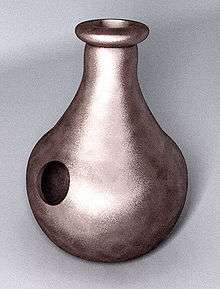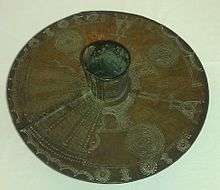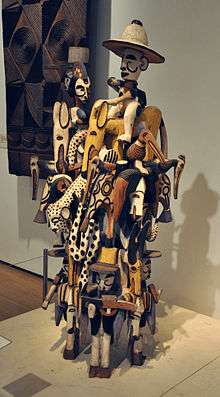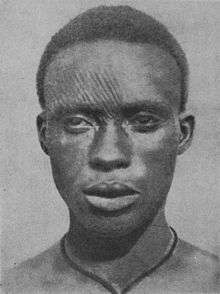Igbo culture
Igbo culture (Igbo: Ọmenala ndị Igbo) are the customs, practices and traditions of the Igbo people[1] of southeastern[2] Nigeria. It comprises archaic practices as well as new concepts added into the Igbo culture either by cultural evolution or by outside influence. These customs and traditions include the Igbo people's visual art, music and dance forms, as well as their attire, cuisine and language dialects.[3] Because of their various subgroups, the variety of their culture is heightened further.
Music

The Igbo peoples have a melodic and symphonic musical style, which they designed from forged iron. Other instruments include opi otherwise known as Oja[4] a wind instrument similar to the flute, igba, and ichaka.[5]
Another popular musical form among Igbo people is highlife, which is a fusion of jazz and traditional music and widely popular in West Africa. The modern Igbo highlife is seen in the works of Prince Nico Mbarga Dr Sir Warrior, Oliver De Coque, Bright Chimezie, celestine ukwu and Chief Osita Osadebe, who are some of the greatest Igbo highlife musicians of the twentieth century. There are also other notable Igbo highlife artists, like the Mike Ejeagha, Paulson Kalu, Ali Chukwuma, Ozoemena Nwa Nsugbe.
Art
Igbo Art is known for various types of masquerade, masks and outfits symbolizing people, animals or abstract conceptions. Igbo art is also known for its bronze castings found in the town of Igbo Ukwu from the 9th century.[6] Igbo art is any body of visual art originating from the people of the Igbo. Igbo culture is a visual art and culture[7]
 Helmet-mask; 20th century; Indianapolis Museum of Art (USA)
Helmet-mask; 20th century; Indianapolis Museum of Art (USA) Female figure for a small temple, 20th century; Indianapolis Museum of Art
Female figure for a small temple, 20th century; Indianapolis Museum of Art Anklet beaten from a solid brass bar of the type worn by Igbo women. Now in the collection of Wolverhampton Art Gallery. The leg-tube extends approx 7 cm each side of the 35 cm disc.[8][9]
Anklet beaten from a solid brass bar of the type worn by Igbo women. Now in the collection of Wolverhampton Art Gallery. The leg-tube extends approx 7 cm each side of the 35 cm disc.[8][9]- Bronze ceremonial vessel in form of a snail shell; 9th century; from Igbo-Ukwu; Nigerian National Museum (Lagos, Nigeria)
.jpg) Eze Onyiudo Masquerade Awka-Etiti
Eze Onyiudo Masquerade Awka-Etiti
Mythology
While today many Igbo people are Christian, the traditional ancient Igbo religion is known as Odinani. In the Igbo mythology, which is part of their ancient religion, the supreme God is called Chineke ("great spirit"); Chineke created the world and everything in it and is associated with all things on Earth. To the ancient Igbo, the Cosmo is divided into four complex parts:[10]
- Okike (Creation)
- Alusi (Supernatural Forces or Deities)
- Mmuo (Spirit)
- Uwa (World)
Alusi

Alusi, also known as Arusi or Arushi, are minor deities that are worshiped and served in Igbo mythology. There are a list of many different Alusi and each has its own purpose. When there is no longer need for the deity it is discarded.[11]
Yam
The yam is very important to the Igbo as it is their staple crop. There are celebrations such as the New yam festival (Igbo: Iri Ji) which are held for the harvesting of the yam.[12]
The New Yam festival (Igbo: Iri ji) is celebrated annually to secure a good harvest of the staple crop. The festival is practiced primarily in Nigeria and other countries in West Africa.[13]
Traditional attire
Traditionally the attire of the Igbo generally consisted of little clothing as the purpose of clothing then was to conceal private parts, although elders were fully clothed.[14] Children were usually nude from birth till their adolescence (the time when they were considered to have something to hide) but sometimes ornaments such as beads were worn around the waist for medical reasons. Uli body art was also used to decorate both men and women in the form of lines forming patterns and shapes on the body.

With colonialism and the Westernization of Igbo culture, Western styled clothes such as shirts and trousers over took traditional clothing.[15]
Women
Women carried their babies on their backs with a strip of clothing binding the two with a knot at her chest. This baby carrying technique was and still is practiced by many people groups across Africa, including the Igbo. This method has been modernized in the form of the child carrier. In most cases Igbo women did not cover their chest areas. Maidens usually wore a short wrapper with beads around their waist with other ornaments such as necklaces and beads.[16] Both men and women wore wrappers.[15]
Men
Men would wear loin cloths that wrapped around their waist and between their legs to be fastened at their back, the type of clothing appropriate for the intense heat as well as jobs such as farming.[15] Men could also tie a wrapper over their loin cloth.
Modern traditional attire
Modern Igbo traditional attire is generally made up, for men, of the Isiagu top which resembles the African Dashiki. Isiagu (or Ishi agu) is usually patterned with lions heads embroidered over the clothing, It can also be plain, (usually black). It is worn with trousers and can be worn with either a traditional title holders hat (a fez named okpu agu or agwu), or with the traditional Igbo stripped men's hat (which resembles the Bobble hat). For women, an embodied puffed sleeve blouse (influenced by European attire) along with two wrappers (usually modern Hollandis material) and a head scarf are worn.
Chieftaincy Title

Highly accomplished men and women are admitted into their noble orders for people of title such as Ndi Ozo or Ndi Nze. These people receive insignia to show their stature. Membership is highly exclusive, and to qualify an individual need to be highly regarded and well-spoken of in the community.
Apprenticeship (Igba Boy)
The Igbo have a unique form of apprenticeship in which either a male family member or a community member will spend time (usually in their teens to their adulthood) with another family, when they work for them. After the time spent with the family, the head of the host household, who is usually the older man who brought the apprentice into his household, will establish (Igbo: idu) the apprentice by either setting up a business for him or giving money or tools by which to make a living.[18]
This practice was exploited by Europeans, who used this practice as a way of trading in enslaved people. Olaudah Equiano, although stolen from his home, was an Igbo person who was forced into service to an African family. He said that he felt part of the family, unlike later, when he was shipped to North America and enslaved in the Thirteen Colonies.[19]
The Igbo apprenticeship system[20] is called Imu Ahia or Igba Boy in igbo land which became more prominent in among the Igbos After the Nigerian civil war. In a quest to survive the £20 policy which was proposed by Obafemi Awolowo that only £20 be given to every Biafran citizen to survive on regardless of what they had in the bank before the war and the rest of the money were held by the Nigerian government.
Petty trade was one of the only ways to build back destroyed communities as well as Farming, but then, farming required time that was not readily available at that moment.
Basically, most people went into trading.[21]
This Imu-Ahia/Igba Boy model was simple, it works in such a way that business owners would take in younger boys which can be relative, sibling or non-relative from same region, house them and have them work as apprentices in business while learning how it works and the secrets of the business. After the allotted time for the training was reached, 5–8 years’ time, a little graduation ceremony would be held for the Nwa Boy (the person that learnt the trade). He would also be paid a lump sum for their services over the years, and the money will be used to start a business for the Nwa Boy.[22]
Osu caste system
Osu are a group of people whose ancestors were dedicated to serving in shrines and temples for the deities of the Igbo, and therefore were deemed property of the gods. Relationships and sometimes interactions with Osu were (and to this day, still are) in many cases, forbidden. To this day being called an Osu remains a stigma that prevents people's progress and lifestyles. [23]
Calendar (Iguafo Igbo)
In the traditional Igbo calendar, a week (Igbo: Izu) has 4 days (Igbo: Ubochi) (Eke, Orie, Afọ, Nkwọ), seven weeks make one month (Igbo: Ọnwa), a month has 28 days and there are 13 months in a year. In the last month, an extra day is added.[24] The names of the days have their roots in the mythology of the Kingdom of Nri. It was believed that Eri, the sky-born founder of the Nri kingdom, had gone on a journey to discover the mystery of time. On his journey he had saluted and counted the four days by the names of the spirits that governed them, and so the names of the spirits (eke, orie, afọ and Nkwo) became the days of the week.[25]
|
An example of a month: Ọnwa Mbụ
|
Naming after market days
Newborn babies were sometimes named after the day of the week when born. This is no longer the fashion. Names such as Mgbeke (maiden [born] on the day of Eke), Mgborie (maiden [born] on the Orie day) are commonly seen among the Igbo people. For males, Mgbe is replaced by Nwa or "Okoro" (Igbo: Child [of]). Examples of this are Solomon Okoronkwo and Nwankwo Kanu, two popular footballers.[28]
Igbo masks and masquerades
There are two basic types of masquerades, visible and invisible. The visible masquerades are meant for the public. They often are more entertaining. Masks used offer a visual appeal for their shapes and forms. In these visible masquerades, performances of harassment, music, dance, and parodies are acted out (Oyeneke 25).
The invisible masquerades take place at night. Sound is the main tool for them. The masquerader uses his voice to scream so it may be heard throughout the village. The masks used are usually fierce looking and their interpretation is only fully understood by the society’s members. These invisible masquerades call upon a silent village to strike fear in the hearts of those not initiated into their society.
Kola nut (Ọjị)
Kola nut (Igbo: Ọjị)[29] occupies a unique position in the cultural life of Igbo people. Ọjị is the first thing served to any visitor in an Igbo home. Ọjị is served before an important function begins, be it marriage ceremony,[30] settlement of family disputes or entering into any type of agreement.[31] Ọjị is traditionally broken into pieces by hand, and if the Kola nut breaks into 3 pieces a special celebration is arranged.
External links
| Wikimedia Commons has media related to Igbo culture. |
- Igboland’s Culture and Language, Igboguide.org
References
- "The Igbo People - Origins & History". faculty.ucr.edu. Retrieved 2020-05-28.
- "Nigeria : History | The Commonwealth". thecommonwealth.org. Retrieved 2020-05-28.
- Adugna, Gabe. "Research: Language Learning: Igbo: Home". library.bu.edu. Retrieved 2020-05-28.
- Nwachukwu, M.A (1997). "ON THE RESONANT FREQUENCIES OF THE OJA". Nigerian Journal of Technology. 18 (1): 1–21 – via ajol.
- http://umunna.org/instruments.htm
- http://www.metmuseum.org/toah/hd/igbo/hd_igbo.htm
- google.com
- "Discomfort of fashion". Antique images and videos of Alaigbo/Ala Igbo (Igboland) posted at Ukpuru blog. 2010-10-17. Retrieved 2013-09-29.
Photograph of dancer wearing anklets - Thomas Whitridge Northcote (pre 1913)
- "Willing Submission to Life Sentence to the Stocks". Antique images and videos of Alaigbo/Ala Igbo (Igboland) posted at Ukpuru blog. 2010-10-17. Retrieved 2013-09-29.
Photograph of female sitting wearing anklets - Thomas Whitridge Northcote (pre 1913)
- Onwuejeogwu, 1975: The Igbo Culture Area in "Igbo Language and Culture," F. Chidozie Ogbalu & E Nolue Emenanjo
- "Archived copy". Archived from the original on 2008-09-13. Retrieved 2008-08-18.CS1 maint: archived copy as title (link)
- Agwu, Kene. "Yam and the Igbos".
- "Celebrating Iwa-ji (New Yam) festival 2005". BBC Birmingham.
- Thing s Fall Apart by Chinua Achebe Page 58: ... the men (i.e. the elders) ... were all fully dressed ...
- http://culture.chiamaka.com/igboclothing.html Archived 2008-09-23 at the Wayback Machine "Igbo People: Clothing & Cosmetic Makeup at the Time of Things Fall Apart"
- Achebe Pg. 71: She (i.e. Akueke) wore a black necklace which hung down in three coils just above her full, succulent breasts... and on her waist, four or five rows of jigida, or waist beads.
- Basden, George Thomas (1921). Among the Ibos of Nigeria: An Account of the Curious & Interesting Habits, Customs & Beliefs of a Little Known African People, by One who Has for Many Years Lived Amongst Them on Close & Intimate Terms. Seeley, Service. p. 184.
- "From Apprenticeship to Enterprise | Ike Chioke | TEDxOguiRoad".
- Olaudah Equiano, The Interesting Narrative of the Life of Olaudah Equiano, or Gustavus Vassa, the African
- "What Is Imu Ahia - What The Igbo Apprenticeship, History, Thought and Terms - Entrepreneur". Entrepreneur. 2018-11-11. Retrieved 2018-11-19.
- "African Indigenous Entrepreneurship Determinants of Resurgence and Growth of Igbo Entrepreneurship During the Post-Biafra Period".
- "The age-old sharing economies of Africa -- and why we should scale them | Robert Neuwirth".
- "The story of Nigeria's 'untouchables'". 2009-04-07.
- Udeani, Chibueze C. (2007). Inculturation as dialogue: Igbo culture and the message of Christ. Rodopi. pp. 28–29. ISBN 978-90-420-2229-4.
- Isichei, Elizabeth Allo (1997). A History of African Societies to 1870. Cambridge University Press. p. 247. ISBN 0-521-45599-5.
- Onwuejeogwu, M. Angulu (1981). An Igbo civilization: Nri kingdom & hegemony. Ethnographica. ISBN 978-123-105-X.
- "Eze Nri - Igu-Aro Festival - 1008th AD". Free-Press-Release Inc. February 29, 2008. Retrieved 2010-04-06.
- "Naming practice guide UK 2006" (PDF). March 2006. Retrieved 2009-04-16.
- Oji (Kola)
- Traditional Marriage In Igboland: The Original Cultural Way
- Igbo Guide Insight into Igbo Language and Culture